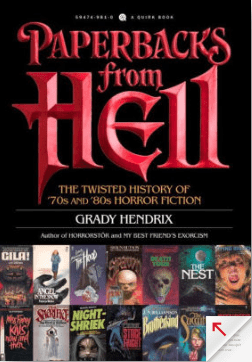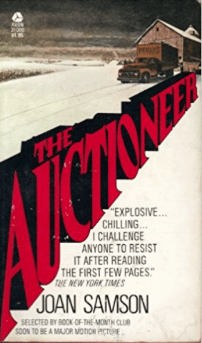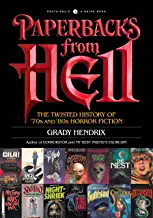Paperbacks from Hell by Grady Hendrix
BookTrib is partnering with Bookish to bring you more great content. Grady Hendrix , author of Horrorstör and My Best Friend’s Exorcism, is a die-hard horror fan. He writes, reads, and researches the genre and is an expert on its history. His new book, Paperbacks from Hell—about the paperback horror boom in the ’70s and ’80s—is a blood-splattered love letter to horror. It’s a tome to be found on the coffee table in any horror fan’s home, brimming with hundreds of full-color cover illustrations from books that influenced both the publishing and film industries. Just in time for Halloween, we talked to Hendrix about the state of horror today, Stephen King brainwashing, and why horror is a women’s genre.
, author of Horrorstör and My Best Friend’s Exorcism, is a die-hard horror fan. He writes, reads, and researches the genre and is an expert on its history. His new book, Paperbacks from Hell—about the paperback horror boom in the ’70s and ’80s—is a blood-splattered love letter to horror. It’s a tome to be found on the coffee table in any horror fan’s home, brimming with hundreds of full-color cover illustrations from books that influenced both the publishing and film industries. Just in time for Halloween, we talked to Hendrix about the state of horror today, Stephen King brainwashing, and why horror is a women’s genre.
Bookish: You clearly have a place in your heart for even the campiest horror novels from the ’70s and ’80s. What is it about these books that draws you in?
Grady Hendrix: These books were designed to be sold in drugstores and bus stations, pharmacy spinner racks and in newsstands, even. They’re designed to hook your attention. Either because they’re about hordes of killer cats, or they’re really lurid and full of sex and violence, or because they just make sure that something incredible or unbelievable is happening on every page. I like them because they’re not boring. But also because they’re from a different tradition.
This isn’t how books get written or published anymore and so the rules are totally different. Three-act structure—it doesn’t exist in some of these books. These books will kill their protagonist halfway through. Nowadays everyone’s used to jump scares, everyone’s used to found footage, everyone’s used to Thomas Ligotti and H. P. Lovecraft and all of those stylistic tics. The only mandate for those horror paperbacks is not to bore the readers. It’s a completely different tradition that comes more out of pulp than it does out of horror.
Bookish: How many paperback originals from the ’70s and ’80s did you actually read in the course of writing this book?
GH: The last time I did a count, it was 326. I could read two a day no problem. It’s what I was doing—I was on the couch all day reading books. Four a day was pushing it. There were a couple of days I did six and those were the days that would wipe me out the next day.
What helped is that I was reading by subgenre. I was reading animal attack books all at once. I was reading all the insect attack books all at once. So I knew what the set pieces were. I got a feel for the structure. Medical thrillers are really, really highly structured in a way that haunted house books are not. Animal attack books, if they’re from England, are structured in a really different way than if they’re from the U.S. Once I got a feel for that structure and where the genre’s signposts were, I could go a lot faster.
Bookish: Is there a book you feature that you think is underrated and would recommend readers pick up?
 GH: Oh hundreds. Anything by Ken Greenhall. Elizabeth Engstrom’s books. Joan Samson’s The Auctioneer. If you’re going for pulpy fun, there’s a couple hundred of these books that I think work really great. If you’re going for serious why-have-we-forgotten-this-author authors, there are dozens. And a lot of them are women. I don’t think V.C. Andrews gets the respect she deserves.
GH: Oh hundreds. Anything by Ken Greenhall. Elizabeth Engstrom’s books. Joan Samson’s The Auctioneer. If you’re going for pulpy fun, there’s a couple hundred of these books that I think work really great. If you’re going for serious why-have-we-forgotten-this-author authors, there are dozens. And a lot of them are women. I don’t think V.C. Andrews gets the respect she deserves.
So many of these authors were great. I wouldn’t have been able to write my book if the books had all been just campy. I found tons of books that were truly either deeply entertaining or truly fantastically well-written. There was a lot to admire here. I mean there’s goofy stuff too and part of my job is to inform and give context. The other part is to entertain. I wanted to do both.
Bookish: You divide the book into sections such as Creepy Kids, Real Estate Nightmares, and Splatterpunks. Were there any subgenres that didn’t make the cut?
GH: Oh sure. Nazis. There’s a ton of books about Nazis: Nazi werewolves, Nazi vampires, Nazi health resorts, haunted Nazi tanks. None of the Nazi stuff made the book. There’s also a whole category of books written by celebrities—like E. Howard Hunt, the Watergate conspirator, and Christina Crawford, Joan Crawford’s daughter. There are also a whole bunch of government intrigue paperbacks like Graham Masterton’s The Condor, and there’s another one called The Hell Candidate. And there are a lot of categories that I just didn’t have enough time to get to in a way I thought was fair. Like the YA stuff. Christopher Pike and R.L. Stine. I didn’t have time to delve into it more simply because I own a small number of those books and they go for a lot of money these days. There’s a huge nostalgia value.
Bookish: In your gothic horror section, you say that horror is a women’s genre. Can you explain what you meant?
 GH: Everyone thinks horror and they think Stephen King. That’s brainwashing. The earliest horror novel that people still read is Mary Shelley’s Frankenstein. And there are two great horror novels of the 20th century—The Haunting of Hill House by Shirley Jackson, and Beloved by Toni Morrison. There’s just not an argument to be made for another book by anyone to rank up there with those two. Another great haunted house novel of the latter half of the 20th century is Anne Rivers Siddons’ The House Next Door. Plus you’ve got V.C. Andrews, Anne Rice… The main proponents of the ghost story in the 19th century were women writers. One of the most famous short horror stories of all time, without which no anthology is complete, is Charlotte Perkins Gilman’s “The Yellow Wallpaper.”
GH: Everyone thinks horror and they think Stephen King. That’s brainwashing. The earliest horror novel that people still read is Mary Shelley’s Frankenstein. And there are two great horror novels of the 20th century—The Haunting of Hill House by Shirley Jackson, and Beloved by Toni Morrison. There’s just not an argument to be made for another book by anyone to rank up there with those two. Another great haunted house novel of the latter half of the 20th century is Anne Rivers Siddons’ The House Next Door. Plus you’ve got V.C. Andrews, Anne Rice… The main proponents of the ghost story in the 19th century were women writers. One of the most famous short horror stories of all time, without which no anthology is complete, is Charlotte Perkins Gilman’s “The Yellow Wallpaper.”
This has really been a women’s genre for a long, long time. Men are late to the party and get all the attention, as seems to be the way of the world.
Bookish: This book is brimming with hundreds of beautifully printed, full-color pictures of old book covers. Does one cover stand out as your favorite? Which is the scariest of the bunch?
 GH: The stuff that’s scary is usually pretty understated. I’ve always thought the original paperback cover of William Peter Blatty’s The Exorcist—that blurred photo of a young woman-is kind of creepy. But… I can’t really pick my favorite out of all the mutant children out there.
GH: The stuff that’s scary is usually pretty understated. I’ve always thought the original paperback cover of William Peter Blatty’s The Exorcist—that blurred photo of a young woman-is kind of creepy. But… I can’t really pick my favorite out of all the mutant children out there.
I got to know a lot of these artists too. I developed a huge amount of respect for what they did. People like Jill Bauman, Stephanie and Mark Gerber, Lisa Falkenstern, and Rowena Morrill— they’re just amazing artists who had the misfortune to be making some of their best efforts in an industry which was designed to be disposable. Illustration has never been as respected as fine art. It’s always been viewed as commercial. And it’s true, it is commercial. But it doesn’t change the fact that it’s rare that an artist can fake their work. They put everything they’ve got into it.
Bookish: In your epilogue, you write “the lesson horror teaches us is that everything dies.” What do you think caused the end of the horror boom?
GH: It was a bunch of things. Publishing was changing. The big publishers were gobbling up the little guys. Everything was consolidating. Some people, like Jill Bauman, say they put the end right on the Gulf & Western acquisition of publishing companies. And other people, like Jeff Conner, who was the publisher of Scream/Press (which did limited edition, really beautiful books), say that it was the beginning of the Reagan ’80s when public libraries were getting less funding and had to watch their budget more. There were definitely changes in distribution too. The mass market paperback went out of style in the ’90s and was replaced by the trade paperback.
On the other hand, Thomas Harris’ The Silence of the Lambs became huge and that coincided with the whole Splatterpunk boom in the mid ’80s. And so you had more and more books being written where a lot of editors would feel like “the more gore in this, the better! That’s what readers really want! That’s what’s popular right now!” There were more books getting produced more cheaply by fewer publishers with fewer channels of distribution. And it was a real recipe for a bubble.
Bookish: Has horror recovered? What is the state of the genre today?
 GH: When I told people I was writing Horrorstör, I could see the light die in their eyes. But when I said it was about a haunted IKEA, people would say, “Oh that’s really funny,” and they’d want to talk about it. Horror still has the connotation that it’s cheap, it’s gory, and it’s misogynistic. And that really just comes from the tail-end of the boom. The hangover from the bubble bursting still exists.
GH: When I told people I was writing Horrorstör, I could see the light die in their eyes. But when I said it was about a haunted IKEA, people would say, “Oh that’s really funny,” and they’d want to talk about it. Horror still has the connotation that it’s cheap, it’s gory, and it’s misogynistic. And that really just comes from the tail-end of the boom. The hangover from the bubble bursting still exists.
However, there are also a ton of books that are coming out now, that either are or are not marketed as horror, that do really well. You’ve got stuff marketed as horror like Victor LaValle’s The Changeling or The Ballad of Black Tom. Or works by John Langan and Paul Tremblay. And then you’ve got stuff that’s marketed as literary fiction like Hari Kunzru’s White Tears, which is a straight-up horror novel about a ghost, but it’s marketed as literary fiction because Kunzru is marketed as literary fiction. I would argue that Colson Whitehead’s Underground Railroad is a horror novel in some sense—or uses a lot of elements from horror.
And then you’ve also got thrillers, which have become the horror of the day. I think Gillian Flynn writes horror. Dark Places is about a satanic murder of a family years ago and someone trying to solve what happened on that night. It’s part mystery, but its roots are in the Satanic Panic. You’ve got all these domestic thrillers that come out too, like a woman bumps her head and wakes up 39 years later and can’t remember her life. Those are gothics right out of the ’60s. They’ve got a little more thriller added to them but it’s a domestic thriller where the nexus of fear is inside the home and the possible monster is the husband. Except traditional gothics pull from the romance tradition in the ’60s and modern gothics are pulling from the thriller tradition.
Bookish: So would you say bookstores and publishers categorize books as horror only if there’s a supernatural element? Or is horror more of a sensibility?
GH: It all depends on how you define horror. If the only thing that says something is horror is whether or not it’s supernatural, then you come up with a really limited definition. Frankenstein is not supernatural—Victor Frankenstein is a scientist. Henry James’ Turn of the Screw is designed to leave you in doubt whether there’s a supernatural element or not. “The Yellow Wallpaper” is about a woman going crazy. Same as Shirley Jackson’s We’ve Always Lived in the Castle. A lot of people use the supernatural thing to determine whether something’s horror or not. But is Cujo horror? Is Misery? Chuck Palahniuk’s short story “Guts” has no supernatural elements in it, yet I think anyone would be hard-pressed to read it and classify it as anything but horror.
Grady Hendrix’s first novel, Horrorstör, an illustrated story about a haunted IKEA, was named by NPR as one of the best books of 2014. He is also the author of My Best Friend’s Exorcism. A diehard horror fiction fan, he lives in New York City.





